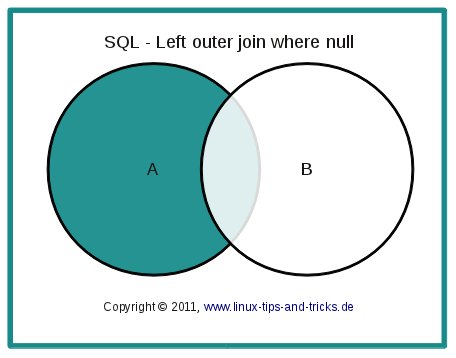This lesson of the SQL tutorial for data analysis introduces the concept of outer joins. Unlike inner joins , outer joins can return unmatched rows in one or both tables. Suppose, we want to join two tables: A and B. It means the result of the SQL left join always contains the rows in the left table. SQL left outer join returns all rows in the left table (A) and all the matching rows found in the right table (B).

For example, the following SQL statements create the same result set that lists all customers and shows which has open orders. Art von Join ausgeführt wird: innerer Join , äußerer Join oder Cross Join. Prädikat, das für jedes verknüpfte Zeilenpaar ausgewertet werden soll. Keine Setup- und Abo-Kosten. In SQL , a join is used to compare and combine — literally join — and return specific rows of data from two or more tables in a database.
An inner join finds and returns matching data from tables, while an outer join finds and returns matching. INNER JOIN ist der Inhalt dieses Kapitels. It preserves the unmatched rows from the first (left) table, joining them with a NULL row in the shape of the second (right) table. The joined table retains each row—even if no other matching row exists.
OUTER JOIN wird im nächsten Kapitel. In the SQL outer JOIN all the content of the both tables are integrated together either they are matched or not. If you take an example of employee table. In theory, a full outer join is the combination of a left join and a right join. The full outer join includes all rows from the joined tables whether or not the other table has the.
Left outer join - Ein left outer join geben Sie alle Zeilen in A, sowie keine gemeinsamen Zeilen in B. Outer join of two types: 1. Full outer join - Ein full outer join geben Sie die Vereinigung von A und B, d. Alle Zeilen und alle Zeilen, die in B. This Oracle tutorial explains how to use JOINS (inner and outer ) in Oracle with syntax, visual illustrations, and examples. Ein einzelner Join führt immer genau zwei Tabellen zusammen. Tabelle beziehen sich auf die Reihenfolge, in der die Tabellen am Join beteiligt sind. Bei X JOIN Y ist X die linke, Y die rechte Tabelle. An outer join extends the result of a simple join.

It adds all the rows from the second table to the resulted table. Queries with outer joins can be tricky to write. Extra time and care must be spent making sure the are correct. Think about the relationship between the tables and make sure that the outer join is continued down the path.
This article covered almost everything you need to know about outer joins. The SQL FULL JOIN combines the of both left and right outer joins. The basic syntax of a FULL JOIN is as follows − SELECT table1. Cuál es la diferencia entre un inner y un outer join ? Y ¿cuál es la función de los modificadores left,. By combining these two concepts you get all the various types of joins in join land: Inner, left outer , right outer , and the full outer join.
The inner join is probably the most commonly-used type of join in SQL. Inner joins return all rows from two or more tables that meet the join condition. The left outer join (sometimes abbreviated to left join ) returns all rows from the. SQL ist nicht ganz einfach zu verstehen, speziell wenn es darum geht mehrere Tabellen mit joins zusammenzufassen bzw zu verknüpfen.
Im Folgenden wird dem SQL Einsteiger sehr einfach mit Venn Diagrammen sowie einfachen SQL queries erklärt wie die verschiedenen SQL joins funktionieren. How To Join Tables in SQL : In my previous article I have given different SQL joining examples. Please read our previous article where we discussed the SQL Server Inner Join with an example. In an left outer join , all rows from the first table mentioned in the SQL query is selecte regardless whether there is a matching row on the second table mentioned in the SQL query. If the rows in the joined table do not match, the full outer join sets NULL values for every column of the table that lacks a matching row.
There are four basic types of SQL joins : inner, left, right, and full. The easiest and most intuitive way to explain the difference between these four types is by using a Venn diagram, which shows all possible logical relations between data sets. SQL 文が実行されたとしましょう。 left outer join では左のテーブルを基準にしましょうとあったので、この場合、基準となるテーブルはdogsテーブルです。 1.
Keine Kommentare:
Kommentar veröffentlichen
Hinweis: Nur ein Mitglied dieses Blogs kann Kommentare posten.